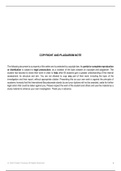COPYRIGHT AND PLAGIARISM NOTE
The following document is a property of the seller and is protected by copyright law. Its partial or complete reproduction
or distribution is subject to legal prosecution, as a violation of the laws existent on copyright and plagiarism. The
student has decided to share their work in order to help other IB students gain a greater understanding of the internal
assessment, its structure and aim. You are not allowed to copy any part of their work, including the topic of the
investigation and their report, without appropriate citation. Presenting this as your own work is against the principle of
academic honesty that the International Baccalaureate stands by and your diploma will not be awarded, aside for further
legal action that could be taken against you. Please respect the work of the student and others and use the material as a
study material to enhance your own investigation. Thank you in advance.
© 2020 Orsalia Toutouza All Rights Reserved 1
, An Investigation on the Effect of Low-Power Microwave Radiation on the Germination
and Seedling Growth of Raphanus Sativus and Triticum Aestivum Seeds
1. INTRODUCTION
1.1 Rationale and Significance
On a personal note, the topic of radiation in agriculture has been recurrent in the agendas of Model United Nations conferences I
have been attending for the past five years, as a sustainable practice which I find truly fascinating, particularly due to its potential to
multiply food production with minimal cost in countries faced with shortage of food supplies and climate conditions preventing mass
cultivation of crops. Microwave radiation is almost harmless and one that could be investigated in a student exploration. From a
variety of crops tested in a preliminary trial, the final ones to be investigated, Raphanus sativus, a fundamental component of
Mediterranean salads, and Triticum aestivum, the basis for bread, are critical in human diet. Thus, accelerating their cultivation is
meaningful, addressing the growing needs of a growing population.
For the past century, microwave radiation has been a fascinating subject of investigation. Its high frequency and short
wavelength are of supreme importance in telecommunications and radars, while several applications in biological research and
medical diagnosis rely on it1. In agriculture, for the past semi-century, microwaves have been used as alternatives to soil additives
and fertilizers, with laser radiation and magnetic fields being much more expensive and dangerous. Despite much research on the
mechanism behind the acceleration microwave radiation causes to seeds, there are only speculations, while the potential for use in
agriculture being greatly promising.
1.2 Background Information
Germination refers to the growth process followed by a seed, spore or relevant reproductive body. In the case of a seed, it leads to
the development of a seedling, which follows a period of dormancy, during which the seed is metabolically inactive. Germination is
a vital part of every plant’s life-cycle, regulating plant population dynamics2.
Germination begins by metabolic activation of the dormant seed via imbibition. During imbibition, water is absorbed by the
embryo, resulting in rehydration and gibberellin production. In turn, gibberellin triggers the synthesis of amylase, which is used for
breaking down starch into maltose. The energy produced by the hydrolysis of maltose to glucose and the formation of cell wall by
the polymerization of maltose to cellulose initiate cell division and nascent (primary) shoot growth. At this time, the rate of respiration
significantly increases and structural changes in the organelles of the seed provoke conformational changes in the seed coat. Once
the seed coat, termed testa, ruptures, the second phase starts. The radicle, the primary root emerging from the seed, grows to be
access minerals and nutrients. As growth continues, the coat is abandoned and the cotyledon emerges, producing leaves3.
Figure 1.2.13: The stages of seed germination in a horizontal array
Out of the several requirements of germination, oxygen for aerobic respiration providing energy, water activating the
metabolic activity and optimal temperature and pH for proper function of enzymes are vital. The optimal value of each varies across
seeds, as there are seeds growing faster in dim light, requiring less water to be activated or calling for more extreme conditions, such
as fire and freezing, in seeds with hard coats requiring weakening or physical damage of the coat to release their radicle. The process
of damaging the coat to facilitate germination is scarification and is closely related to the topic of this investigation 4.
Mohsenkhah et al. (2018) investigated the effect of microwave radiation on germination of Capsicum Annum L. (pepper),
concluding that radiation increases the coat’s and the surroundings’ temperature and as higher temperature accelerates enzyme
1 Lucas, J. (2018, February 9). “What Are Microwaves?”. Retrieved June 14, 2019 from https://www.livescience.com/50259-microwaves.html.
2 Heslop-Harrison, John. (2018, December 21) “Germination.” Encyclopædia Britannica Inc., Retrieved June 14, 2019 from
www.britannica.com/science/germination.
3 Cornell, Brent. “Germination Stages.” Retrieved June 13, 2019 from https://ib.bioninja.com.au/higher-level/topic-9-plant-biology/untitled-
3/germination-stages.html
4 “Ibid.
© 2020 Orsalia Toutouza All Rights Reserved 2




